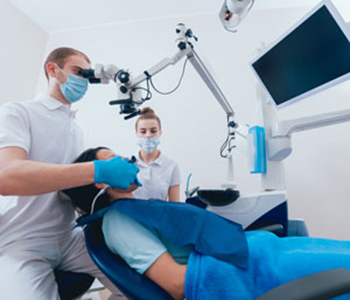Root canal therapy is typically a straightforward procedure similar to that of getting a dental filling. In each procedure, we ensure our patient is comfortable before, during, and after treatment. We do this by explaining the various details that may surround treatment, and answering any questions that the patient has. Especially when root canal treatment is needed, we want to make sure the patient feels confident in moving forward with care, understanding the need, our method, and recovery well in advance.
Sometimes, what is needed to repair a tooth that has been damaged by infection within the pulp chamber is surgical root canal therapy. This more in-depth procedure may be needed after non-surgical therapy, if successful results could not be obtained. There are a few reasons a surgical approach may be taken, such as:
- Both the root surface and bone have been damaged by infection and require repair.
- Previous root canal therapy did not heal optimally.
- The root canal cannot be accessed through the crown of the tooth.
Surgical root canal therapy is performed under local anesthetic, just like non-surgical treatment. Patients may take advantage of one of our various forms of sedation if they feel any anxiety about undergoing this procedure. To us, patient comfort extends beyond numbing the area on which we are working. We understand certain treatments may seem daunting, and we want to assure each patient that he or she is in good hands.
Surgical root canal therapy actually has the same purpose as the standard treatment, to remove infected tissue from the pulp chamber and cleanse the area. A common part of the surgical root canal, also called an apicoectomy, is the filling of the lowest point of the root canal after the canal has been thoroughly cleaned. This is called a retrograde filling. One of the goals in our Buffalo dental practice is to avoid the use of mercury fillings, producing healthier, more attractive smiles. Though a retrograde filling is not seen in the smile, we will carefully choose materials for this filling to aid in full healing.
Some of the factors we look for in retrograde fillings include:
- Quick-setting
- Proven effective in clinical tests
- Consistency in shape
- Optimal setting at edges
- High capacity for sealing
- Biocompatibility
- Simple, effective application
- Non-absorbable
Dr. Kent has many years of experience handling dental problems that range from mild to complex. At Smile Center, your smile is in good hands.


